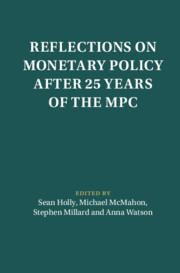Book contents
- Reflections on Monetary Policy after 25 Years of the MPC
- Macroeconomic Policy Making
- Reflections on Monetary Policy after 25 Years of the MPC
- Copyright page
- Contents
- Figures
- Tables
- Contributors
- I Overview
- II Communication
- III Targets and Instruments
- 6 The MPC Remit at 25: Growing Pains?
- 7 Raising the Inflation Target
- 8 What Have We Learnt about Unconventional Monetary Policy Tools? Lessons from the Global Pandemic
- 9 Finding New Objectives, Seeking New Instruments
- 10 Government Debt Management and Monetary Policy Before and After the MPC
- IV MPC Process
- V Lessons for Central Bank Independence
- Annex: Details on the methodology for the classification of level of disagreement
- Index
- References
9 - Finding New Objectives, Seeking New Instruments
from III - Targets and Instruments
Published online by Cambridge University Press: 14 November 2024
- Reflections on Monetary Policy after 25 Years of the MPC
- Macroeconomic Policy Making
- Reflections on Monetary Policy after 25 Years of the MPC
- Copyright page
- Contents
- Figures
- Tables
- Contributors
- I Overview
- II Communication
- III Targets and Instruments
- 6 The MPC Remit at 25: Growing Pains?
- 7 Raising the Inflation Target
- 8 What Have We Learnt about Unconventional Monetary Policy Tools? Lessons from the Global Pandemic
- 9 Finding New Objectives, Seeking New Instruments
- 10 Government Debt Management and Monetary Policy Before and After the MPC
- IV MPC Process
- V Lessons for Central Bank Independence
- Annex: Details on the methodology for the classification of level of disagreement
- Index
- References
Summary
The adoption of inflation targets in the U.K, with the Monetary Policy Committee given instrument independence in 1997, is often presented as the answer to the assignment problem: the MPC was made responsible for the single objective of price stability, to be attained via its deployment of its single instrument, the policy rate. This chapter uses this perspective to examine the evolution of the workings of monetary policy and the MPC over its first twenty-five years, how the Bank and the MPC, came across additional possible objectives and searched for additional possible instruments. implying the need for some recasting of the role of the MPC and the way in which it operates.
- Type
- Chapter
- Information
- Reflections on Monetary Policy after 25 Years of the MPC , pp. 107 - 118Publisher: Cambridge University PressPrint publication year: 2024

